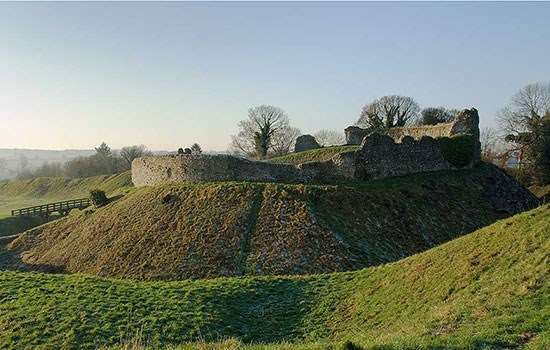Foundation of the Priory
In the early 1070s William de Warenne – a Norman knight who had fought alongside William the Conqueror at Hastings – chose Acre in Norfolk as the headquarters for his East Anglian landholdings. One of the many Normans whose fortunes were transformed by the conquest of England, he had accumulated lands across the country, including an estate in Norfolk. There were also important Warenne estates centred on Lewes in Sussex (the family’s main English seat) and Conisbrough in Yorkshire.
Within a few years of the Conquest, William de Warenne had built a castle at Acre, and between 1081 and 1085 he brought a small community of monks there from his earlier foundation at Lewes, which had been the first monastery of the Cluniac order in England.
Read more about Castle Acre CastleA New Site
William I de Warenne died in 1088, and it was his son, William II de Warenne, 2nd Earl of Surrey, who in 1089 granted the monks a new site and the increased resources that enabled them to begin the existing buildings of Castle Acre Priory, beside the River Nar. As one of his charters tells us, he gave them
two orchards and all the ploughland from the said orchards up to my castle in which … they have founded their church, because that same place in which they now live is too confined and highly unsuitable for the dwelling of monks.
Building progressed slowly. The church was not consecrated until 1146–8, and its west end was completed only in the 1160s. The monks probably moved from the castle bailey to their new site in about 1100, once the east end of the church was ready. They would have lived in timber buildings while the rest of the priory was completed over the next 50 years.
Download a plan of the prioryThe Later Middle Ages
The priory continued to attract benefactors, including gifts from the second earl’s descendants – the last endowment was made by the sixth earl in 1315. Much of the monks’ expenditure went on building – particularly in the 12th century – as well as almsgiving, hospitality, and maintaining up to 36 monks and a large number of servants.
From the 13th century we have occasional glimpses of the priory’s internal affairs from the ‘visitations’ of officials, usually the priors of other Cluniac monasteries. In 1265, for example, the 32 monks were rebuked for ‘the habit of journeying and riding about the country, eating and drinking indifferently in the houses of laymen and secular persons’. In 1283, trouble erupted when the Earl of Surrey and the prior of Lewes proposed rival candidates as prior of Castle Acre. The earl sent soldiers to intimidate his opponents, and only relented when the abbot of Cluny himself intervened.
Like other ‘alien priories’ in England – those that depended on Cluny or other French monasteries – Castle Acre suffered from restrictions and punitive taxation during the wars with France in the late 13th and 14th centuries, even though the monks themselves were mostly English. Eventually it secured ‘English’ status in 1325. Boosted by this, the monks made many improvements to the buildings in the later 14th century. It was at this time that the eastern end of the church was rebuilt and extended. In the early 16th century the prior’s lodging was much enlarged and beautified, and the fine gatehouse was built.
The Suppression and After
After almost a thousand years of development, England’s monasteries – then about 800 in number – were wiped out in the later 1530s during Henry VIII’s Suppression of the Monasteries. At Castle Acre the deed of surrender was signed on 22 November 1537 by the prior, Thomas Malling, and ten monks. They were probably granted small pensions and some, as was also usual, may have become parish or chantry priests. Much of the church was almost immediately demolished.
The priory’s site and lands were then leased to John Howard, 3rd Duke of Norfolk, who sold them to Sir Thomas Gresham in 1558. By this time the monastic buildings were being removed, although the prior’s lodging was retained as a house, and stayed in use well into the 17th century. In 1615 the Castle Acre property came into the hands of the lawyer and politician Sir Edward Coke, in whose family it remains today.
Picturesque Ruins
The picturesque ruins began to attract the attention of antiquarians from the early 18th century, and by the second half of the century were attracting regular visits from local gentry and their guests. In 1804 the artist John Sell Cotman spent four days drawing at Castle Acre, when the prior’s lodging was in use as part of the Abbey Farm. In the late 19th century excavations by the great antiquary William St John Hope helped to make the priory ruins both easier to see and better understood.
The main priory buildings were taken into State guardianship in 1929, and extensive repairs were made. English Heritage has cared for Castle Acre Priory since 1984. Today, the castle, priory and massive 12th-century town defences at Castle Acre offer a rare and powerful impression of the impact of the Norman Conquest on all levels of society in England.
Buy the Guidebook to Castle Acre Priory and CastleFind out more
-

History of Castle Acre Castle
Read more about the history of the castle begun in the 1070s by William de Warenne, who had fought at the Battle of Hastings.
-

History of Conisbrough Castle
Find out more about the history of the Warennes’ castle at Conisbrough, which lay at the heart of their northern estates.
-

Find more property histories
Search our resources to discover the history of other English Heritage properties, which span the story of England from prehistory to the Cold War.
